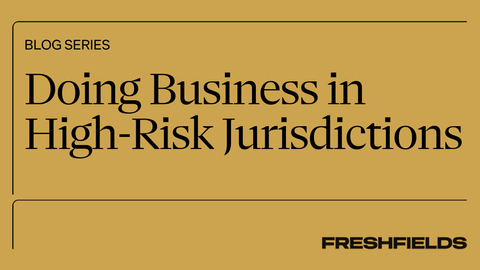Introduction and recap
On 1 October 2023, the EU’s Carbon Border Adjustment Mechanism (CBAM), the development of which we have been following closely (please see here for an overview), entered into force. It is based on EU Regulation 2023/956, published on 16 May 2023 in the Official Journal of the EU.
Under CBAM, importers of certain, emission-heavy goods will eventually be required to surrender CBAM certificates when imported into the EU, with the price of CBAM certificates pegged to the EU ETS. In its current version, CBAM will apply to the importation of electricity, cement, iron, steel, aluminium, fertiliser and hydrogen (CBAM goods), but it is possible that further items may still be added in the future.
Transitional phase from October 2023
Implementation of CBAM starts with a transitional phase, running 1 October 2023 until 31 December 2025. During this period, no authorisation is yet required for the import of CBAM goods and no CBAM certificates have yet to be surrendered. Instead, the obligation of importers is limited to reporting. This transition period is intended to pave the way for the later CBAM-certificates stage (starting 1 January 2026).
In an implementing regulation 2023/1773 (Implementing Regulation), the European Commission (EC) has specified detailed rules on reporting obligations, alongside two detailed manuals addressing (i) importers of goods into the EU, and (ii) installation operators outside the EU.
This overview explores the key features of the Implementing Regulation.
Who is subject to reporting obligations?
CBAM reporting obligations are closely tied to customs compliance. They affect the following groups defined as Reporting Declarants:
- importers who lodge customs declarations for the release of CBAM goods for free circulation in their own name and on their own behalf (including persons holding authorisations to lodge customs declarations in the form of entries in the declarant's records declaring the importation of relevant goods)
- indirect customs representatives (i.e., service providers filing customs declarations in their own name but on behalf of their clients) in cases where (i) the client is established outside of the EU, or (ii) the indirect customs representative has agreed to assume the reporting obligations from the (EU-based) client.
During the transitional period, there is no distinct clearance and registration process for Reporting Declarants. By contrast, as of 1 January 2026, only authorised CBAM declarants will be allowed to import CBAM goods into the EU, with authorisation depending upon clearance by the national CBAM authority.
Scope of CBAM reporting obligations during transition
Reporting Declarants are subject to quarterly reporting obligations, with reports to be filed no later than one month after the end of each quarter. They must contain:
- the quantity and Combined Nomenclature (CN) codes of the CBAM goods imported (expressed in megawatt hours for electricity and in tonnes for other goods), and
- information on the embedded emissions of the CBAM goods, including detailed information on the production site and production routes.
The Implementing Regulation contains detailed rules on the calculation of embedded emission in its annexes. For the first month of the transitional phase, it still allows for certain simplifications which will be phased out gradually.
Specifically, until 31 July 2024, the Reporting Declarant may essentially choose their own method, including relying on default values to be made available by the EC. Until 31 December 2024, they may base ther calculations on any institutionalised emission pricing/monitoring scheme. This means that a calculation of embedded emissions in accordance with the Implementing Regulation’s methodology will only be mandatory from 1 January 2025 onwards.
Administration regarding CBAM reporting
CBAM reports must be filed via the CBAM transitional registry, a standardised electronic database run by the EC. The registry enables communication between the EC, the competent authorities, the customs authorities, and the Reporting Declarants.
The EC may check CBAM reports to assess compliance with the reporting obligations. Where it considers a CBAM report incomplete or incorrect, the EC communicates its indicative assessment regarding the report to the competent authority in the EU Member State where the Reporting Declarant is established. Furthermore, the EC communicates to the EU Member States a list of EU-resident Reporting Declarants for which it has reason to believe have failed to comply with the obligation to submit a CBAM report.
The Member States’ competent authorities review and assess the data and information provided by the EC within three months after receipt. If incomplete or incorrect CBAM reports have been received or a report has not been submitted at all, the competent authority may initiate a correction procedure, i.e. notify the Reporting Declarant that its report is under review and request additional information.
Enforcement / Penalties
The Implementing Regulation provides for a duty for the Member States to apply penalties where:
- the Reporting Declarant has not taken the necessary steps to comply with the obligation to submit a CBAM report
- the CBAM report is incorrect or incomplete and the Reporting Declarant has not taken the necessary steps to correct it after the competent authority initiated a correction procedure.
The penalties are quite severe, reaching between EUR 10 and EUR 50 per tonne of unreported emissions. It is still not entirely clear if the EC will require these penalties to be automated or if the Member States’ authorities will have discretion to determine whether and to what extent they apply. The information provided in the guidance document on CBAM implementation for importers of goods seems to indicate that the Member States’ authorities will have discretion.
Against this background, compliance with the CBAM reporting duties is crucial, especially for those who import goods with significant embedded emissions. Continuous non-compliance with reporting duties during the transitional phase may also affect the importer’s accreditation as an authorised CBAM declarant, which will be a mandatory prerequisite for the importation of CBAM goods once CBAM has become fully operational (and which, inter alia, requires a declaration on the tax/customs-compliance status of the applicant).
Outlook
With quarterly reporting obligations and first reports due by 31 January 2024, CBAM should already be high on the agenda of CBAM goods importers. As reporting demands are set to gradually increase until 1 January 2025, there is still time to study the Implementing Regulation’s methodology. Despite the extensive guidance documents published by the EC, we have not yet seen much traction at the level of national competent authorities, with some basic information missing (such as which national authority will be designated as national CBAM authority and which procedural law (tax or general administrative law) will be applied when administering CBAM. It remains to be seen how quickly CBAM can be mastered by both Reporting Declarants and national competent authorities alike.



/Passle/581a17a93d947604e43db2f0/MediaLibrary/Images/2025-10-21-10-30-43-502-68f760d3a94b3b874acc7f85.png)

